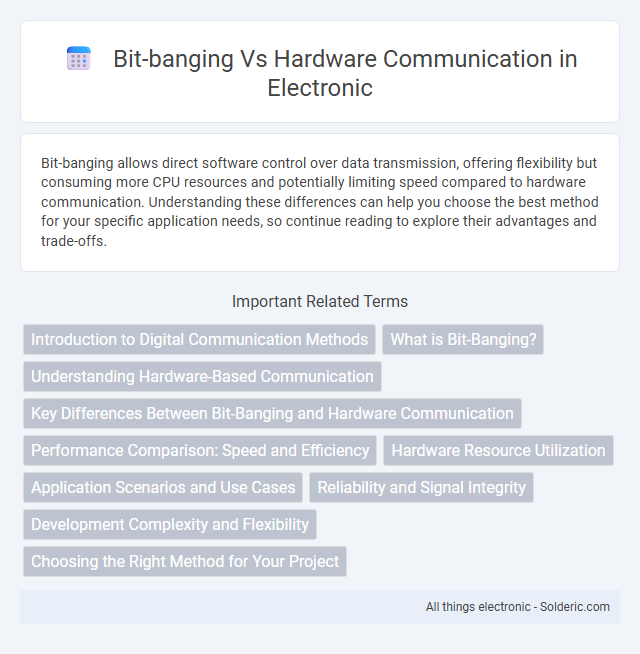Bit-banging allows direct software control over data transmission, offering flexibility but consuming more CPU resources and potentially limiting speed compared to hardware communication. Understanding these differences can help you choose the best method for your specific application needs, so continue reading to explore their advantages and trade-offs.
Comparison Table
| Feature | Bit-banging | Hardware Communication |
|---|---|---|
| Definition | Software-driven manual signal generation | Dedicated hardware modules for signal handling |
| Speed | Slower; limited by CPU processing | Faster; hardware-accelerated communication |
| CPU Load | High; continuous CPU intervention required | Low; offloads tasks from the CPU |
| Complexity | Simple hardware, complex software | Complex hardware, simpler software |
| Accuracy | Less accurate; timing sensitive | High accuracy and reliable timing |
| Flexibility | Highly flexible; any protocol can be implemented | Limited to hardware-supported protocols |
| Power Consumption | Higher due to CPU usage | Lower thanks to hardware efficiency |
| Examples | Software SPI, I2C implemented via GPIO | SPI, UART controllers on microcontrollers |
Introduction to Digital Communication Methods
Bit-banging is a software-driven technique that manually controls digital signal lines to simulate communication protocols, offering flexibility but higher CPU usage. Hardware communication utilizes dedicated peripherals such as UART, SPI, or I2C modules, providing faster and more reliable data transfer with minimal processor intervention. Choosing between bit-banging and hardware communication depends on factors like resource availability, speed requirements, and system complexity in digital communication methods.
What is Bit-Banging?
Bit-banging is a technique in embedded systems where microcontrollers manually control communication protocols by toggling I/O pins through software rather than relying on dedicated hardware modules. This method allows for flexible and cost-effective implementation of serial communication protocols like SPI, I2C, or UART but often results in higher CPU usage and lower data transfer speeds. Bit-banging is typically employed when hardware communication peripherals are unavailable or when customization beyond standard hardware capabilities is required.
Understanding Hardware-Based Communication
Hardware-based communication utilizes dedicated modules like UART, SPI, and I2C to manage data transmission efficiently, reducing CPU load and increasing overall system reliability. These peripherals handle timing and protocol complexities automatically, ensuring precise signal generation and error detection. By relying on hardware, your microcontroller can perform other tasks simultaneously, enhancing performance in embedded systems.
Key Differences Between Bit-Banging and Hardware Communication
Bit-banging involves manually controlling data lines via software to simulate communication protocols, while hardware communication relies on dedicated peripheral modules for automatic data handling. Bit-banging offers flexibility and ease of implementation on microcontrollers without built-in peripherals but demands higher CPU usage and precise timing control. In contrast, hardware communication provides efficient, reliable data transfer with minimal processor intervention, enhancing overall system performance and reducing timing errors in Your embedded projects.
Performance Comparison: Speed and Efficiency
Bit-banging communication relies on software-driven signal timing, resulting in slower data transfer rates and higher CPU usage compared to hardware communication modules that handle protocols internally. Hardware communication interfaces, such as SPI or I2C peripherals, achieve higher speeds and greater efficiency by offloading signal generation and timing to dedicated circuitry. This allows hardware communication to deliver consistent timing, reduced latency, and lower processing overhead, enhancing overall system performance in time-critical applications.
Hardware Resource Utilization
Bit-banging demands minimal specialized hardware, relying heavily on the microcontroller's CPU to manually toggle GPIO pins for data transmission, which can lead to increased CPU utilization and slower processing speeds. Hardware communication modules like UART, SPI, or I2C offload data handling tasks from the CPU, freeing up resources and enabling more efficient multitasking and faster communication. Choosing hardware communication reduces your system's processing burden, optimizing overall hardware resource utilization for complex or time-sensitive applications.
Application Scenarios and Use Cases
Bit-banging is ideal for low-speed, low-complexity applications where hardware resources are limited, such as simple sensor interfacing or custom communication protocols in microcontroller projects. Hardware communication excels in high-speed data transfer and reliability, making it suitable for applications like Ethernet, USB, and SPI interfaces in industrial automation or consumer electronics. Your choice between bit-banging and hardware communication depends on the specific performance requirements and resource availability in your embedded system design.
Reliability and Signal Integrity
Bit-banging offers flexibility in communication protocols but often suffers from lower reliability and signal integrity due to software-timed signal generation, which is prone to timing jitter and processor interruptions. Hardware communication modules use dedicated peripherals like UART, SPI, or I2C controllers that provide precise timing and robust signal management, significantly enhancing signal integrity and reducing error rates. Consequently, hardware communication ensures more consistent data transfer performance, especially in noisy or high-speed environments.
Development Complexity and Flexibility
Bit-banging offers greater flexibility in communication protocols by allowing custom timing and data formats through software control, but it significantly increases development complexity due to precise timing requirements and processor overhead. Hardware communication controllers simplify development by handling protocol timing and error detection automatically, reducing software complexity and improving reliability. Your choice between bit-banging and hardware communication depends on the trade-off between the need for protocol flexibility and the desire for streamlined, efficient development.
Choosing the Right Method for Your Project
Bit-banging offers flexibility and low cost for simple or low-speed communication protocols but requires significant CPU resources, making it less efficient for complex or high-speed tasks. Hardware communication leverages dedicated peripherals like UART, SPI, or I2C controllers, providing faster, more reliable data transfer and freeing your processor for other tasks. Choosing the right method depends on your project's speed requirements, complexity, power consumption, and available microcontroller resources.
Bit-banging vs Hardware Communication Infographic

 solderic.com
solderic.com